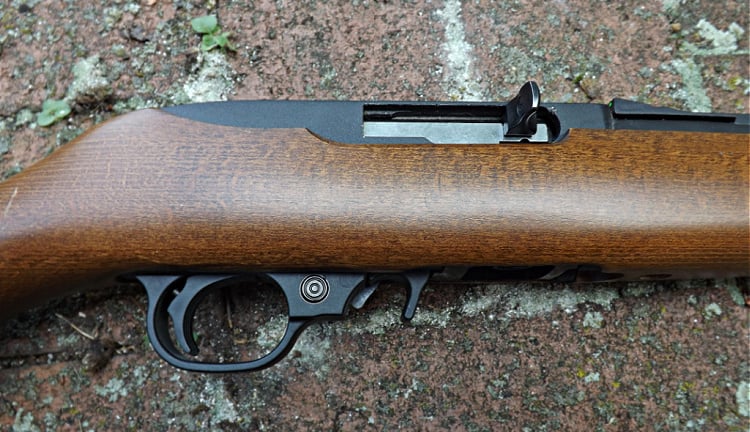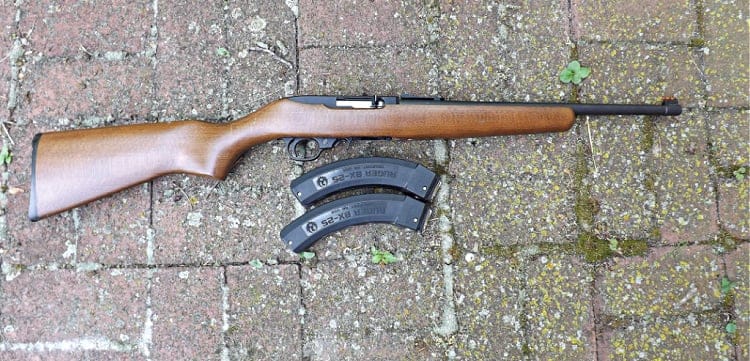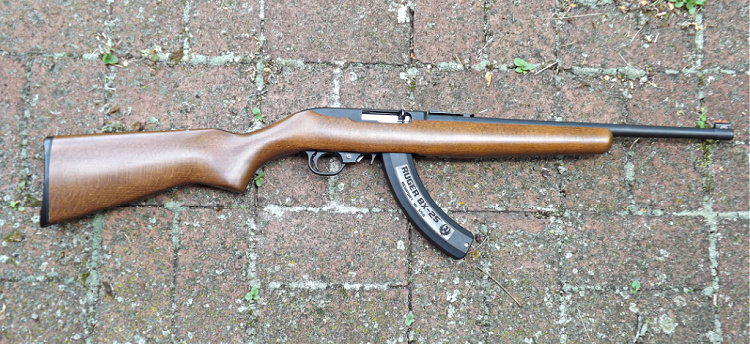A large percentage of shooters cut their teeth on the .22, having fired their first shots with this all-American caliber. As such, it needs little introduction, since there is probably not a gun enthusiast in the country who is not very familiar with it.
A firearm that needs very little introduction is the Ruger 10/22, considering what an icon it is.
Ruger first began producing the 10/22 in 1964, and it has been going strong ever since. How strong? Over seven million have been produced so far, and it is still in demand! It is one of the most popular rimfires in history, and it seems that everyone has one in their collection. Some people have several, it seems they’re like potato chips; it’s hard to have just one.
Reasons For Popularity
Back in 1965, the price of a brand new 10/22 was $54.50. These days, the retail price is around $299.00, which is fairly reasonable, considering that these can usually be found for well under retail.
For that price, the buyer gets a compact, lightweight, reliable, accurate, fast-handling carbine. Many .22 semi-autos at that time were less than reliable, and the 10/22 quickly developed a reputation for reliability, which elevated it into a separate realm than others. The 10-round rotary magazine was also a boon, in that it fits flush with the stock, offers a decent capacity for such a little carbine, and is extremely durable. It’s a simple design that just works.
The carbine operates with a blowback action, and there is a crossbolt safety at the trigger guard, which is convenient to manipulate. The current magazine release is a lever-type and works well.

The standard carbine model weighs five pounds, with an overall length of 37 inches. It owes the light weight to an aluminum alloy receiver. The barrel is 18.5 inches, and it wears an American Walnut stock. It’s easy to see that it truly is compact and light in weight. The fact that there is essentially no recoil is also an asset for new shooters.
One thing that may have helped to endear the 10/22 to the public of the 1960s is the fact that it bears at least a passing resemblance to the M-1 carbine of WWII fame. And at that point in history, WWII had been over for less than 20 years. Perhaps some of the endearment of the M-1’s looks
transferred over to the little Ruger carbine.

Another asset to its appearance is that it looks like many hunting rifles with its classic wood stock. It doesn’t look threatening in its pure form, lacking black plastic parts. If you are after a low profile carbine that doesn’t upset the populace, look no further than the 10/22.
Ruger 10/22 Variants
The 10/22 took off like a rocket ship headed for the moon, and in short order, Ruger began introducing new models, with varying stocks and other options. To date, I believe there have been around two dozen different variations of the 10/22, with more likely to occur, if I had to guess.
A few of the variants that are currently available include those chambered in the .22 LR, .22 Magnum, and .17 HMR.
There is a 10/22 Takedown model that was introduced in 2012, which breaks down into two main components for easy storage. A pistol version, the Charger, comes with a bipod affixed. There is also an All-Weather version that has all stainless steel for durability.
The 10/22 Tactical Model has a synthetic stock and can be had in two choices of barrels, with one being a 16-inch bull barrel. It comes without sights, but has a scope base. Some of these have been fitted with sound suppressors for law enforcement and military use. A good suppressor on a 10/22, coupled with subsonic ammunition, will make the carbine so quiet that when it’s fired, all that you hear is the action working.
My favorite variant, one that I currently own, is the Compact model, which features a 16.2-inch barrel, fiber optic sights, and a weight of just 4.5 pounds. It truly is compact, and it handles so well in close quarters!


Although the 10-round magazines offer a decent capacity, Ruger listened to the masses who wished for more capacity. Ask, and ye shall receive! Ruger introduced a factory 25-round magazine, and it proved to be a game-changer. A capacity of 25 rounds elevates this little carbine to the level of a serious self- defense tool.


As expected, the 25-round magazine functions flawlessly. It is also built sturdy; when you hold it, it is not a flimsy, cheap plastic unit. It is substantial and will last through quite a bit of abuse.

Ruger 10/22 Use and Maintenance
For those who love to customize their firearms, look no further than the 10/22. Next to the 1911 and the AR-15, there is no other firearm that has more accessories available than the 10/22. A veritable cottage industry exists, offering triggers, barrels, stocks, sights, scope mounts, and every other part that the reader could possibly imagine.
Field stripping the 10/22 is not complex and can be accomplished in moments for cleaning or maintenance. I’m okay with the entire procedure until I get to the part where the bolt is taken out of the receiver. I can get the bolt out just fine, but getting it back into the receiver is a serious challenge for me. The first time I did it, it took me about 90 minutes to get it back into the receiver, and my hands were bloody at the end of that miserable affair (in full disclosure, I’m not a mechanically-inclined person). I have resolved that when I need to clean it, I will hit that area with aerosol gun cleaner, lubricate it, and call it a day without removing the bolt from the receiver.
Accuracy among the different versions varies, ranging from good to amazing. 50 to 100 yards is the limitation for the .22LR, as it runs out of steam past 100 yards. People have tricked out 10/22s with heavy barrels, aftermarket stocks, and superb optics that make them tack drivers.
A good friend of mine has one of the first 10/22 carbines that rolled off the assembly line. After countless tens of thousands of rounds, he recently decided to send the rifle back to Ruger for them to check out and perform maintenance on. Not long after, his rifle was returned, free of charge, with several parts replaced, and the rifle appeared to be close to new mechanically. Needless to say, he was elated with the service he received!
Survival/Self Defense
Some people do not consider the lowly .22 Long Rifle to be a viable defensive caliber. It’s true that it certainly has limitations. The velocity is not terribly high. The projectiles are not heavy, and they make small holes. One cannot deny that these drawbacks do exist.
Would I trust it for self-defense? Yes, with the caveat that it would not be my first choice for many situations. The .22LR is not powerful, and at the lower velocities, a stretch cavity will not be substantial. Shot placement is going to be critical if you are engaging live targets, obviously. I’d prefer something in 5.56mm or 7.63x39mm for combat.
With that said, I wouldn’t feel terribly under-armed if I had my 10/22 and several 25-round magazines. Anyone coming for me would be in a world of hurt. One advantage of using the .22LR indoors is that the lower sound would not be as catastrophic to your hearing as a weapon in, say, 5.56mm.
The fact that it is so short and maneuverable, coupled with the low recoil that allows me to engage many targets very quickly, along with high magazine capacity, gives me the confidence to say that I could make it work for close range. Realizing the limitations of the gun and cartridge are
necessary.
As mentioned, shot placement would be paramount, with headshots being taken when available. I’d venture the guess that a hostile humanoid being struck in the brain bucket with a .22LR just might cause his birth certificate to expire.
However, there are also quite a few advantages to the .22LR:
- The bullets don’t weigh much. You can throw 1,000 rounds of .22LR into a day pack and hit the woods without it weighing you down badly. That’s a substantial supply of ammunition to easily transport. And it does not take up a lot of room, either.
- It is inexpensive. .22LR sells for a lot less than other calibers. One can typically pick up a box of 500 rounds for between $25 and $30. For that price, you can stockpile a lot of this ammo. Long after I’ve run out of other calibers in an emergency, I will still have .22LR left.
- Because it is inexpensive, you can practice and train a lot with this caliber. You can affordably build skills with it, which is important.
- The low noise level is good for new shooters to learn to shoot with. Also, there may be instances where you don’t want to attract a lot of attention with your blaster. The .22 wins in this category.
- Low recoil. Again, this is an advantage for teaching new shooters good shooting habits. It also allows you to put a lot of rounds on target very quickly because you’re not dealing with recoil.
- Penetration. The .22LR will penetrate fairly deeply, as the bullets tend to hold together and not fragment.
- Long barrel life due to moderate velocities.
- Availability. Any place that sells bullets will likely have the .22LR available.
Choosing Your .22 Ammo
Let’s check out some bullet weights and velocities. These are very general, and only meant to give a rough idea of some of the bullets and velocities available:
- CCI Velocitor – 40 grains – 1,435 feet per second.
- CCI Min Mag – 36 grains – 1,260 feet per second.
- Remington Golden Bullet – 40 grains – 1,255 feet per second.
- Remington Thunderbolt – 40 grains – 1,255 feet per second.
- CCI Stinger – 32 grains – 1,640 feet per second.
There are hollowpoints available, but the velocity often isn’t enough to help them expand, and they tend to act like solid projectiles. As a result, I usually just go for solid projectiles in this caliber. The .22 LR has taken just about every game animal known to man, from squirrels and rabbits up to (reportedly) an elephant. For large animals, the ear canal might be the target to go for, directly to the brain. Poachers take deer at night all the time with the .22 for a reason already mentioned: it is quiet.
No one in his right mind would choose it as his primary hunting caliber for game of any size. But in a survival situation where you’ve bugged out and are desperate, you can make it work in a pinch.
The Ruger 10/22 Has Plenty to Offer


If you’re after a lightweight, handy, inexpensive carbine for both beginner and advanced shooters that fires a common, inexpensive caliber, strongly consider the Ruger 10/22 in one of its many versions. For self-defense to survival, or just plain fun plinking at the range, it can fill the bill nicely.
Don’t write off the .22 Long Rifle either, as it has much to offer in these modern times. Together, this cartridge and carbine have much to offer.



Pingback: The Five Worst Guns I've Ever Owned - The Mag Life()